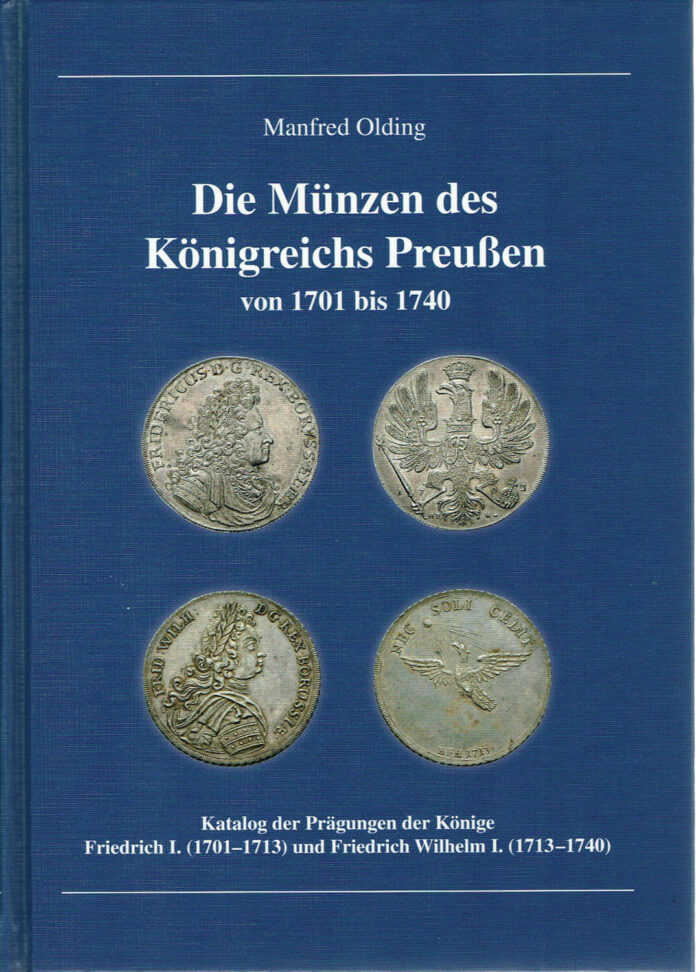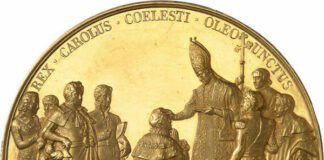
Once again Manfred Olding has turned his attention to the coins of the Kingdom of Prussia. And once again, he has produced a new benchmark publication for the respective time period.
His newest volume covers the coins of the Kingdom of Prussia between 1701 and 1740. Those year dates bracket the reign of two very different kings: Frederick I. (King 1701-1713, Elector of Brandenburg since 1688) became the first King of Prussia, opted for opulence befitting his rank, and built castles (among them one which was recently rebuilt in Berlin, or at least its façade). His son, Frederick William I. is known as the “Soldier King,” who skimped on everything but his troops, of which, however, he was too fond to employ them. It was only his son who put the inherited troops and refilled state coffers to use to wage his wars – Frederick the Great. That is, by and large, the Prussian historiography.
Olding is not the first to write a catalogue on the Prussian coins from this period; several others have done so before him (for example Friedrich von Schrötter in 1902 and Klaus Martin in 1976). When reading Olding’s book, however, you can be sure that what you’re holding in your hands is the most up-to-date research. The expert for Prussian coins has written this catalogue after decades of researching and engaging with this topic. On the one hand, he has managed to dig up some hitherto unknown variants from various coin cabinets. On the other hand, his expertise allows him to confidently delete incorrect entries from the prewar literature, which floated around as citations but never actually existed.
The catalogue is organized first by rulers, then by metals (silver and gold), then by coin type (Kurantgeld or Scheidemünze), and finally by mint. Listed in addition are coins from dependencies like those of the Principality of Minden or of Neuenburg in Switzerland, which are missing from many older catalogues. The coin types are numbered coherently and described in few words with the most important information. Moreover, the catalogue is extensively illustrated, sometimes by depicting several variants of one type. This makes it a sensibly structured, easy-to-use catalogue – also for non-German speakers.
Olding complements this with tables on denominations and standards, a list of mint masters and die cutters, and tables with the annual mintage sorted by mint. These are all the bonuses you get, because Olding resists the temptation to overload the book with too much extra information. Why would he, one might add, since you can easily read up on the historical context and monetary history elsewhere. This yields a reference work which provides all relevant catalogue information in a clear and simple manner, and on less than 200 pages.
With The Coins of the Kingdom of Prussia, 1701-1740, Olding once again puts out a catalog which is everything you wished for, and more: it closes a gap. If you include his previous catalogues, The Coins of the Kingdom of Prussia, 1786-1873 (German: Die Münzen des Königreichs Preußen von 1786 bis 1873) and The Coins of Frederick the Great, 1740-1786 (German: Die Münzen Friedrichs des Großen 1740-1786), Olding covers the entirety of the Kingdom of Prussia – from its foundation in 1701 to its unification with the German Reich in 1871. Whoever possesses these three catalogues has done well for himself. Like the other Olding works, this one will certainly become a standard reference work for the coins of Frederick I. and Frederick William I.
The one minor flaw of this catalogue is that it is missing the supplement with market prices that was included in The Coins of the Kingdom of Prussia, 1786-1873 at its publication in 2014 – in 2019, the publisher even released an updated, separately purchasable list with valuations. Maybe such a list will still be published at a later point – collectors and dealers would certainly be delighted.
Visit the coin shop of Manfred Olding online (in German).
Read our review of The medals of Frederick William II by the same author.
You can order the catalogue at Gietl publishing.



